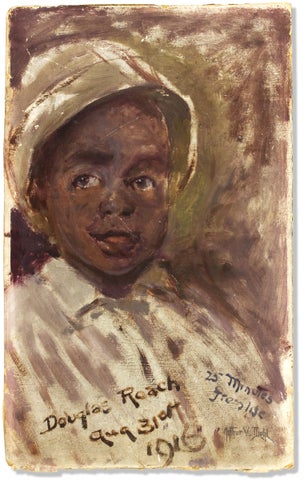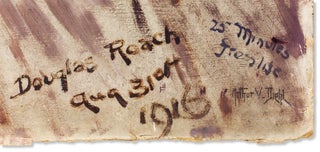Original 1916 Portrait of Douglass Roach of Provincetown, Massachusetts.
“Roach received a hero’s funeral” – “Thousands lined the streets for his impressive Harlem service.”
A previously-unknown portrait of Douglas Roach (1909–1938), as a seven year-old Provincetown boy, by the Cape Cod artist Arthur Vidal Diehl.
Described as a “lost American hero” by historian Tukufu Zuberi, Roach would grow up to become “one of the best machine gunners in the entire Spanish war. Franco had nobody like him and he was an army by himself.” (“Episode 902, Story 2 – Spanish Civil War Eulogy.” History Detectives, PBS)
At Cape Cod’s tip, Provincetown claims Roach as one of its distinguished citizens and one of the few Black Americans who lived there in the early twentieth century. Roach’s father was an émigré whaler from St. Vincent. He arrived on the Cape in the nineteenth century and became a farmer.
Douglas Roach was one of the few African-Americans to attend UMass Amherst in 1929, where he was a star wrestler. He then worked as a carpenter, in the merchant marines, and joined the International Seamen’s Union. Afterwards, he became the secretary of the Communist Party’s Provincetown Unit, arguing forcefully and publicly, at one point, that the Constitution protected free speech and allowed its citizens to petition its government to redress grievances.
In 1936, when the Spanish Civil War began, Roach joined the Abraham Lincoln Brigade, which held the first non-segregated units in U.S. military history. A subunit, the Lincoln Battalion, counted ninety African-Americans. Roach, then twenty-eight, was among them. A comrade-in-arms stated:
“Doug was proud of his race. He felt deeply the oppression under which it struggles, and gladly gave his aid to help free it. He knew that the cause of the Spanish people was the cause of his own people, the cause of all the oppressed races of the world. He spoke many times of his plans to work among the American Negroes when he got back, how he was really beginning to see the tremendous role they must play in the fight to preserve democracy in America. He bitterly resented not having done more when he was home.” (Building Provincetown)
According to Benjamin J. Davis, Jr.’s eulogy, Roach was “one of the first Americans to volunteer in defense of Spanish democracy in the early days of the Madrid siege. An outstanding member of the Tom Mooney machine gun company, he often carried his machine gun single-handedly during long marches.”
In a letter sent home, published as “Douglas Roach Tells of War in Spain” within The Advocate (Sept. 30, 1937), Roach stated:
“I believe the fight for democracy in Spain is connected with the fight against reaction everywhere, against aggressive countries such as Italy, Germany and Japan, who are dragging the world into another world war. I hope that the people of Provincetown will defend Americanism in this country as bravely as the Spanish people are defending their democratic rights: a government of their own choice, freedom of speech, freedom of assembly and freedom of worship. I hope that we will not allow our American traditions of liberty and justice to be distorted by reactionaries who preach Americanism and practice the opposite.”
At Brunete, Roach received shrapnel wounds:
He was “treated at a makeshift Brigade hospital and furloughed to the States. When he got to New York, the State Department interrogated him and confiscated his passport before allowing him to return home to Provincetown [...] He died of pneumonia July 13, 1938 [...] After a memorial service at the Mother A.M.E. Zion Church conducted by Benjamin Robeson, Paul Robeson’s brother, two Lincoln vets, Walter Garland and Paul Burns brought his body home to Provincetown.” (“Douglas Roach Biography” via Provincetown History Project)
Created in “25 minutes from life,” Roach’s portraitist, Arthur Vidal Diehl, exhibited at the Royal Academy (1899) and came to New York c. 1891. “He was best known for his paintings [of] Cape Cod—and was known to have completed his pictures rapidly, from memory, while carrying on conversations with prospective customers and onlookers at his studio.” (Falk)
Painted in the fleeting youth of Roach’s boyhood, this portrait documents and commemorates Roach’s brief, but remarkable, twenty-nine-year life.
Description: Original 1916 Portrait of Douglass Roach of Provincetown, Massachusetts.
[Provincetown, “Douglas Roach August 31st 1916”]. Oil painting on masonite board, 20 x 12 inches. Unframed, some scuffing along bottom edge, verso with old staining.
[3731995]Refs. Roach, Douglas Bryan – The Abraham Lincoln Brigade Archives and Building Provincetown…, both accessed online. Davis, “The Death of a Black Communist” within Black Americans in the Spanish People’s War Against Fascism 1936–1939. Note: Several online sources state that Roach was born in 1900. This is incorrect. He was born June 1, 1909.
Price: $22,500.00

![[3731995] Original 1916 Portrait of Douglass Roach of Provincetown, Massachusetts. Arthur Vidal Diehl.](https://rareamericana.cdn.bibliopolis.com/pictures/3731995.jpg?width=768&height=1000&fit=bounds&auto=webp&v=1711907371)


